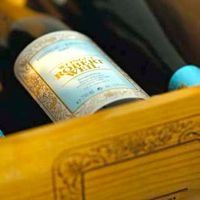Robert Weil, Kiedrich Turmberg Riesling trocken 2009 Rheingau

From 19.90 euros, 34 Swiss francs, 298 Norwegian krone, Aus$79.95 a bottle and £185 a dozen in bond. [For an importer's comments on the issue of tax on wine in Australia, see here on the forum.]
This week's wine has been chosen to celebrate Germany's increasingly important wine fair Prowein this weekend. See also this week's Some top Rheingau Rieslings and Tasting beyond the VDP.
VDP member Robert Weil is widely acknowledged as one of the most consistent producers of great Rheingau Riesling, from bone-dry, high-extract wines right up to a remarkable track record of Trockenbeerenauslesen. Their most famous wines, from Kiedrich's Gräfenberg vineyard, are some of Germany's most expensive wines, all with these distinctive pale blue labels. (The company is now owned by Suntory of Japan but is still run by Wilhelm Weil and team.)
In 1971, when the infamous new German Wine Law was formulated, there was widespread reorganisation and neatening up of the wine map. A distinct vineyard just above Gräfenberg, until then known as Turmberg, was incorporated into Gräfenberg and all its produce sold as such. But in 2005, the Turmberg parcel was reinstated as an individual vineyard site, all 3.8 ha owned by Robert Weil, who had managed to convince the government of this plot's very distinctive nature. Much of Turmberg is too steep to cultivate but wine produced on it has a distinct, more 'mineral' character (with apologies to this discussion of the nebulous concept of minerality on our forum). Gräfenberg has particularly good access to water (its vines didn't even suffer water stress in 2003) and so this is regarded as Weil's top site, the one labelled Erstes Gewächs for its dry Rieslings, year in and year out. But because it's higher, it's cooler and the wines tend to be a little leaner but in a vintage as ripe as 2009, this can almost be a bonus.When I first tasted it last August, I found Robert Weil, Kiedrich Turmberg Riesling trocken 2009 Rheingau almost painfully tight and recommended keeping it for a while, but when I saw it again earlier this month I absolutely loved it and thought you could start to enjoy this bone-dry Riesling already, while the Gräfenberg is a little richer and is labelled 13.5% as opposed to the 13% on the label of the Turmberg.
This impeccably made, textbook dry Rheingau Riesling reminds me of dry grapefruit juice on the nose but it is the tingly raciness on the palate that makes it such a revitalising drink. Not that it is spritzig but it tastes as though energy were bubbling up through the slate and phyllite here. This would make a great first-course wine for a smart dinner and could be enjoyed any time over the next five years, I suspect.
The Turm, or tower, in the name Turmberg incidentally refers to the very visible remains of the keep of the castle built on a crag there in the twelfth century, probably to protect trade routes which, in the Middle Ages, were significant conduits of wine. Modern wine drinkers tend to forget just how old are German roots in the wine business and that the Romans cultivated vines here. Purple pagers can read some of the longest entries of all, on German wine history, in their online Oxford Companion to Wine.
The price of this wine varies enormously, from under 20 euros a bottle in Germany to the equivalent of 26, 37 and 58(!) in Australia. The Justerini & Brooks price of £185 a dozen in bond would work out to about £20, the equivalent of around 22 euros, a bottle – a very fair price compared with the price of white burgundies of comparable quality.
Become a member to view this article and thousands more!
- 15,417 featured articles
- 274,327 wine reviews
- Maps from The World Atlas of Wine, 8th edition (RRP £50)
- The Oxford Companion to Wine, 5th edition (RRP £50)
- Members’ forum
- 15,417 featured articles
- 274,327 wine reviews
- Maps from The World Atlas of Wine, 8th edition (RRP £50)
- The Oxford Companion to Wine, 5th edition (RRP £50)
- Members’ forum
- Commercial use of our Tasting Notes
